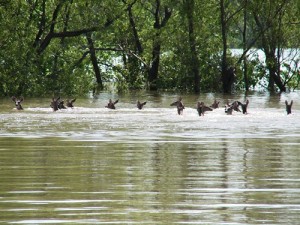 The recent bomb cyclone combined with spring snowmelt has swelled some Midwest rivers to record levels and forced the evacuation of hundreds of homes. The governors of Nebraska, Iowa and Wisconsin have declared emergencies. Some of the water-logged areas are bracing for more rain this week.
The recent bomb cyclone combined with spring snowmelt has swelled some Midwest rivers to record levels and forced the evacuation of hundreds of homes. The governors of Nebraska, Iowa and Wisconsin have declared emergencies. Some of the water-logged areas are bracing for more rain this week.
How will all this flooding affect whitetail deer in the region?
Biologists say that rising floodwaters of river and creeks won’t kill many if any adult deer, though it will displace the animals for days and weeks. But the deer will eventually filter back into their habitats once the waters recede.
Good news is that pregnant does will move out of rising water now and for the next few weeks. The primary concern for deer herds in and around flood zones is later on in May and June, when the does start dropping fawns.
“But fawn survival in flood plains is typically very high, even during flood years,” says noted whitetail scientist Grant Woods. “To cause any significant problems in a herd, the water levels would have to rise very rapidly and be timed when the peak of fawn births occur, and before the fawns are mobile. This is a relatively narrow window of time. Rivers rarely rise that quickly, and does are excellent mothers.”
One concern, though, is how the current Midwestern flooding might wash away and/or flatten preferred fawning cover for later on this spring. “If does are forced to fawn in fields or woods where there isn’t as much cover as usual, coyote predation on the fawns can increase,” says Grant.
The cumulative effects of the bomb cyclone, snowmelt and flooding later on this spring could impact fawning cover in some areas, but that remains to be seen.





